Technologies
Solar Eclipse Spectacle: Key Times and Streaming Options You Should Know
The great American eclipse is on Monday. Here’s how to witness the last one over North America for 20 years, even if you can’t be there.
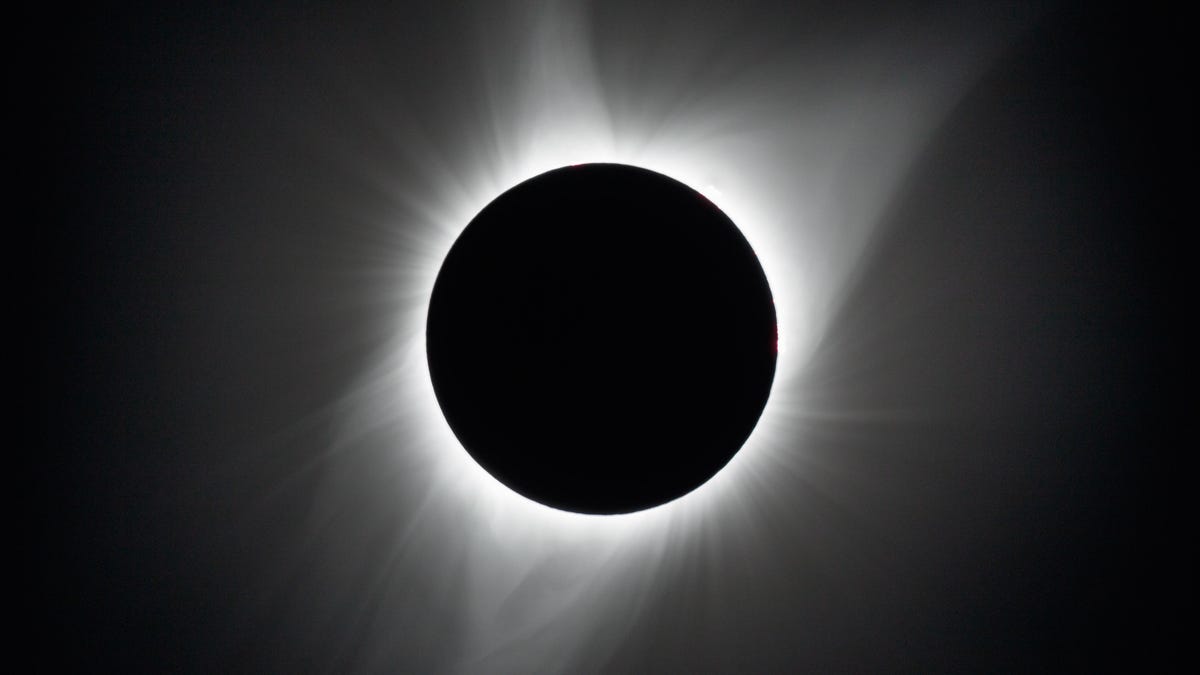
The «great American eclipse» is almost here, and you shouldn’t let this rare celestial event pass you by. On Monday, the last total solar eclipse over North America until 2044 will be visible for several minutes. If you don’t see this one, it’s a 20-year wait for the next.
A total solar eclipse happens when the moon passes between the Earth and the sun, blocking the sun and turning an otherwise sunny day to darkness for a short period of time. Depending on the angle at which you’re viewing the eclipse, you may see the sun completely shrouded by the moon (called totality) or some variation of it. The more off-angle you are and the farther you are from the path of the eclipse, the less likely you’ll be to see the totality.
The 2024 total solar eclipse will happen on Monday. It will reach the Mexican Pacific coast on April 8 at 11:07 a.m. PT (2:07 p.m. ET), and then traverse the US in a northeasterly direction from Texas to Maine and on into easternmost Canada.
Not everyone can travel to see it, but you may happen to live somewhere on that path of totality. Here’s a look at some of the options to nab a chance to see this rare sight, and what to know about the great American eclipse.
Total solar eclipse path
The eclipse will cross over the Pacific coast of Mexico and head northeast over mainland Mexico. The eclipse will then make its way over San Antonio at approximately 2:30 p.m. ET on April 8 and move through Texas, over the southeastern part of Oklahoma and northern Arkansas by 2:50 p.m. ET.
By 3 p.m. ET, the eclipse will be over southern Illinois, and just 5 minutes later, will be traveling over Indianapolis. Folks in northwestern Ohio will be treated to the eclipse by 3:15 p.m. ET, and it will then travel over Lake Erie and Buffalo, New York, by 3:20 p.m. ET. Over the next 10 minutes, the eclipse will be seen over northern New York state, then over Vermont. By 3:35 p.m. ET, the eclipse will work its way into Canada and off the Eastern coast of North America.

Best places to watch the Great American Eclipse
When evaluating the best places to watch this year’s total eclipse, you’ll first want to determine where you’ll have the best angle to see the totality. The farther off-angle you are — in other words, the farther north or south of the eclipse’s path — the less of an impact you can expect.
Therefore, if you want to have the best chance of experiencing the eclipse, you’ll want to be in its path. As of this writing, most of the cities in the eclipse’s path have some hotel availability, but rooms are getting pricey. Major cities on the path include San Antonio, Dallas and Austin in Texas; Columbus and Cleveland in Ohio; Indianapolis; Little Rock, Arkansas; and Buffalo and Rochester in New York.
You could even book a seat in the sky — Delta Airlines made headlines for offering two flights that allow you to see the entire path of totality. Its first eclipse flight, from Austin, Texas, to Detroit, sold out quickly, with Delta offering a second from Dallas to Detroit that still has seats available. Delta also has five other flights that will (coincidentally) offer prime eclipse viewing.

Can’t travel? Where to watch the eclipse live stream
NASA will be hosting a 3-hour live stream of the eclipse starting at 1 p.m. ET, with commentary by NASA experts, astronauts on the international space station and looks at watch parties across the nation. It will feature views from locations in the path of totality, including Dallas and Kerrville, Texas; Russellville, Arkansas; NASA’s Glenn Research Center in Ohio; Indianapolis; Carbondale, Illinois; Niagara Falls, New York; and Houlton, Maine.
You can watch the live broadcast on streaming service NASA Plus, NASA TV or on NASA’s website. Nasdaq will also carry coverage of part of the NASA TV broadcast and will live stream it on its screen in Times Square.
Eclipse eye safety and photography
As with any solar eclipse, it’s critical you keep eye safety in mind.
During the eclipse, and especially during the periods before and after totality, don’t look directly at the sun without special eye protection. Also, be sure not to look at the sun through a camera (including the camera on your phone), binoculars, a telescope or any other viewing device. This could cause serious eye injury. Sunglasses aren’t enough to protect your eyes from damage.
If you want to view the eclipse, you’ll instead need solar viewing glasses that comply with the ISO 12312-2 safety standard. Anything that doesn’t meet that standard or greater won’t be dark enough to protect your eyes. Want to get them for free? If you’ve got a Warby Parker eyeglasses store nearby, the company is giving away free, ISO-certified solar eclipse glasses at all of its stores from April 1 until the eclipse, while supplies last.
If you don’t have eclipse viewing glasses handy, you can instead use indirect methods for viewing the eclipse, like a pinhole projector.
Read more: A Photographer’s Adventure With the Eclipse
In the event you want to take pictures of the eclipse, attach a certified solar filter to your camera. Doing so will protect your eyes and allow you to take photos while you view the eclipse through your lens.
There’s also a new app to help you both protect your eyes and take better photos of the eclipse on your phone. Solar Snap, designed by a former Hubble Space Telescope astronomer, comes with a Solar Snap camera filter that attaches to the back of an iPhone or Android phone, along with solar eclipse glasses for protecting your eyesight during the event. After you attach the filter to your phone, you can use the free Solar Snap Eclipse app to zoom in on the eclipse, adjust exposure and other camera settings, and ultimately take better shots of the eclipse.
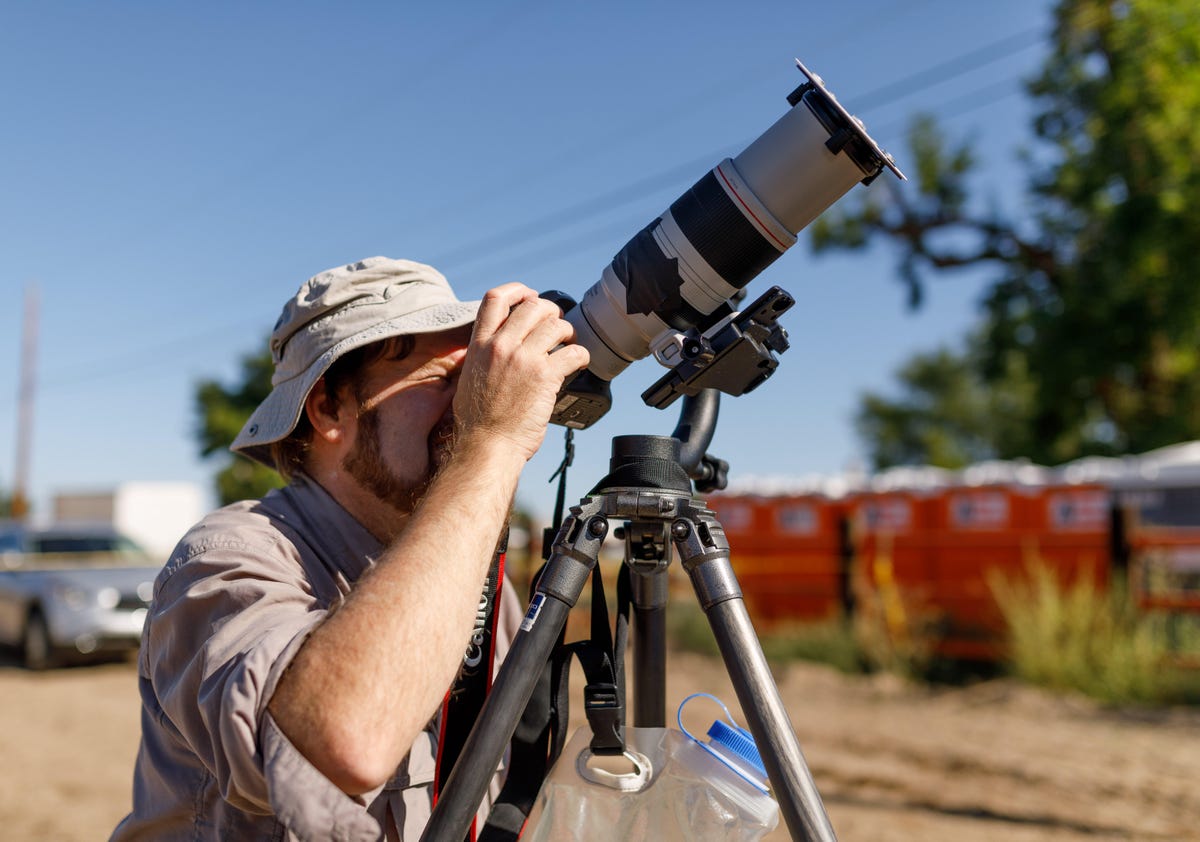
Watching the total eclipse from space
You don’t even have to be on Earth to watch the eclipse. Astronauts aboard the International Space Station will have multiple chances to witness this rare event.
«(Astronauts) aboard the orbiting laboratory will have three opportunities to view the ground shadow (penumbra and umbra) of the moon as it tracks across the Earth surface during the total solar eclipse,» NASA said. «After encountering the eclipse shadow above the Pacific Ocean, then during a pass from the New Zealand area to California and Idaho, the space station is predicted to encounter the eclipse during a time of near-to-full totality while over Maine and New Brunswick around 3:30 p.m. EDT.»
But the astronauts still need to protect their eyes, just as Earth’s eclipse-watchers do.
«Safety first still applies in space!» NASA wrote in an Instagram post. «The crew will not directly image the eclipse for the same reason we here on Earth should not look directly at the sun during the eclipse, except during the brief total phase of a total solar eclipse, when the Moon completely blocks the sun’s bright face.»
Even those of us on earth can help out NASA. The Eclipse Soundscapes Project is a NASA Citizen Science project studying how eclipses impact life on Earth. The project is asking for the public’s help, and it’ll use gathered information to revisit a century-old eclipse study about how animals and insects are affected by solar eclipses.
The simplest way to get involved is to read up on how to use your observations from that day to help NASA gather information. Sign up, and then go outside on eclipse day and record your observations and share them as requested. Observers can be on the path of totality, but they don’t have to be. NASA will give participants a certificate for submitting their observations.
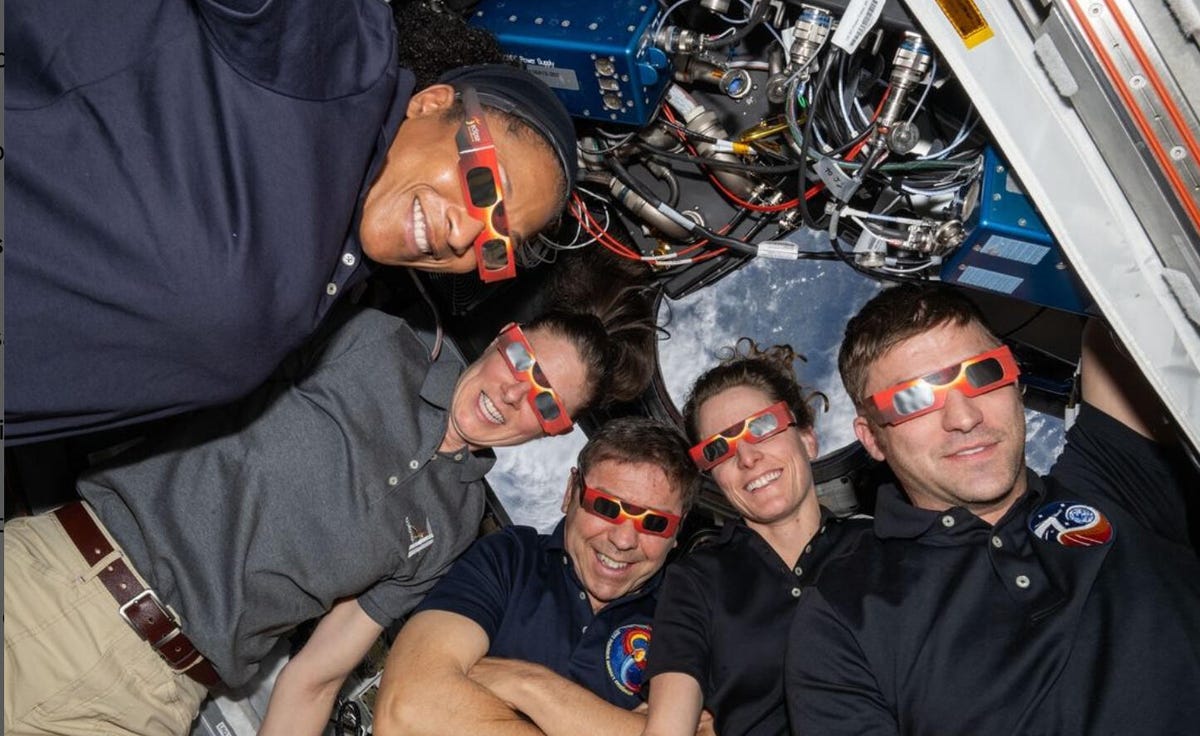
2024 eclipse compared to 2017
The last total solar eclipse occurred in 2017, and many Americans had a great view. Although there are plenty of similarities between the 2017 total solar eclipse and the one coming April 8, there are a handful of differences. Mainly, the 2024 eclipse is going to cover more land and last longer.
The 2017 eclipse started over the northwest US and moved southeast. Additionally, that eclipse’s path was up to 71 miles wide, compared with a maximum width of 122 miles for this year’s eclipse. Perhaps most importantly, the moon completely covered the sun for just 2 minutes, 40 seconds in 2017. This year, maximum totality will last for nearly four-and-a-half minutes.
For more on the Great American Eclipse, check out CNET’s coverage on expert eye protection and viewing tips, where to get free solar eclipse glasses, how to figure out if your eclipse glasses are safe or fake and whether your solar panels will be affected by the total solar eclipse.
Technologies
Galaxy Z TriFold vs. Huawei Mate XT: One Is the Most Versatile Phone I’ve Ever Used
Samsung’s Galaxy Z TriFold and Huawei’s Mate XT, part of a new category of phones called «trifolds,» offer diverging experiences when it comes to using them.
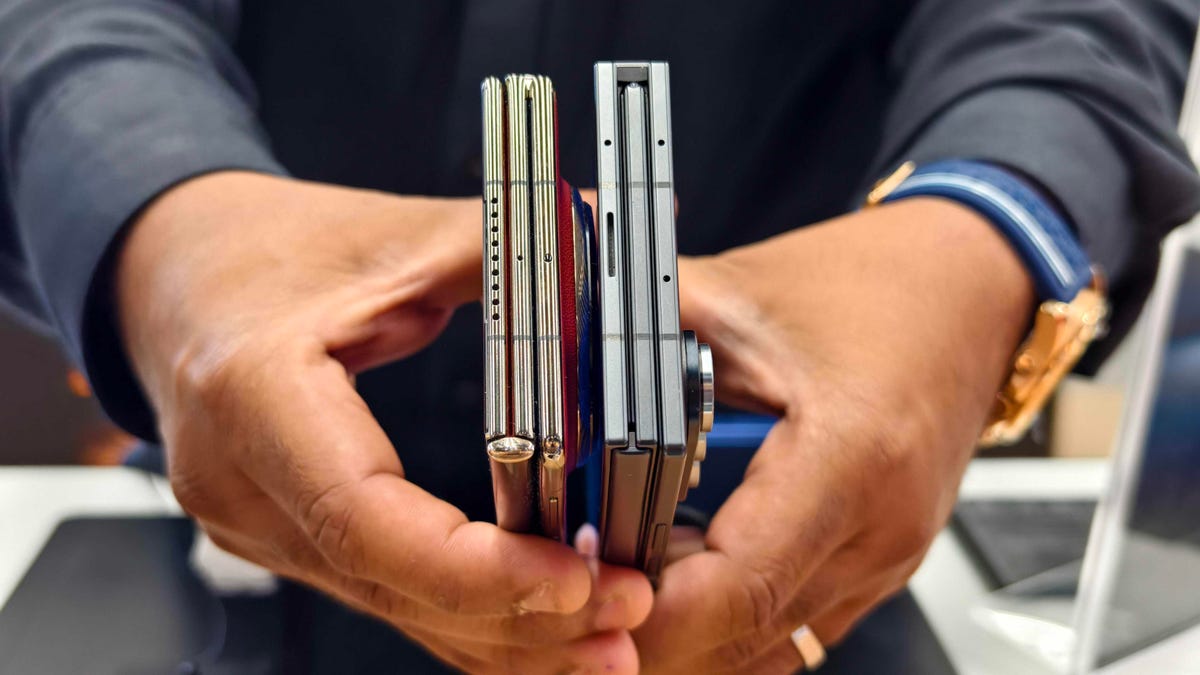
Huawei introduced the world’s first «trifold» phone, the Mate XT Ultimate, last year and launched it outside of China in February 2025. Despite only actually folding in two places, the phone was called a trifold because its 10.2-inch display divides into three sections.
I’ve been using it on and off since February and I liked the Mate XT so much that it made me skeptical about the Galaxy Z TriFold‘s design when Samsung first showcased it at the APEC CEO Summit in October. But after trying Samsung’s first trifold for myself, during a brief hands-on test at a Samsung store in Dubai, I changed my mind.
As foldable phone sales are expected to rise 30% year over year in 2026, according to analysts at IDC, it’s important for both Samsung and Huawei to find their own hook for customers. Each of these foldable phones has their place in the market and offers a different appeal. One is a tablet that folds into a phone, while the other is a three-in-one and the most versatile smartphone I’ve ever used. One of them has «Z TriFold» in its name but the other actually folds in a «Z» shape.
Here’s how the newly-launched Samsung trifold phone compares to the Huawei Mate XT Ultimate — the phone that pioneered this category.
Samsung Galaxy Z TriFold vs. Huawei Mate XT design
Both the Galaxy Z TriFold and Mate XT have large screens that divide into three panels (hence the name) and have two hinges to connect them. And yet, they’re vastly different.
The Huawei trifold phone has a single screen that folds in a Z shape to allow for three different forms. You can use it as a phone (fully folded), a mini-tablet (half-open), as well as a wide-screen tablet (fully opened). I’ve mostly used the Mate XT either in mini-tablet mode (one fold) or fully unfolded. And I found myself using it in phone mode (fully closed) only when I made calls.
In comparison, the Galaxy Z TriFold folds in a U shape as both panels fold inwards. You can only use it fully folded as a phone or fully opened as a wide-screen tablet, without the added ability to use it as a mini tablet.
Samsung’s Z Trifold uses two different-sized hinges and three panels of varying thickness, allowing the device’s flaps to fold on top of one another. The left hinge is like the one on the Fold 7 and comparatively tighter than the right hinge (the wider one), which springs open after you push it to a certain angle. On the back of the phone is a second display that occupies the «middle» section to use when the phone is fully closed.
When fully folded, its lowermost panel has a protruding edge, giving it a solid lip to grab onto while unfolding. It’s a nice addition to the flat-sided design, which doesn’t leave much space between panels. I found it easier to unfold than its sibling, the flat-sided Galaxy Z Fold 7.
The Huawei Mate XT has curved sides and a single screen, but because of that Z shape, it gives you three ways to use it. The right hinge unfolds like the Galaxy Z TriFold — you pull it out — but you don’t need to unfold the other side. With just one panel unfolded, it becomes a usable mini-tablet.
You can unfold the third section, at the back of the left panel, to open it fully and use it as a wide-screen tablet. Because it uses a single flexible screen, part of the soft folding display is always exposed to the elements when the device is folded shut in phone mode. So far, I haven’t noticed any scratches on the display but it is definitely less protected than Samsung’s inner screen. However, Huawei bundles a case with an extended lip to protect the always-exposed right side of the screen.
Both of these trifold phones have minimal screen creases but Samsung’s Galaxy Z TriFold feels better when I run my finger over the folding parts. While Huawei’s creases are deeper, they don’t bother me in day-to-day use. The creases on both phones are visible under direct artificial light and at an extreme angle.
The Huawei Mate XT is slimmer than the Galaxy Z TriFold. It’s just 3.6mm thick at its thinnest part when fully unfolded and 12.8mm when folded. In comparison, the Samsung phone is 3.9mm thick at its thinnest part and goes up to 12.9mm when fully unfolded. At 309 grams, the Z TriFold is also slightly heavier than the 298g Mate XT.
The Huawei trifold phone feels more premium than the Galaxy Z TriFold — probably because of its faux leather back, curved sides and gold accents. Samsung’s foldable has a carbon-fiber finish, which feels durable but not as premium.
The Mate XT has an IPX8 rating, while the Galaxy Z TriFold is rated IP48 for dust and water resistance. The «4» in IP48 means it’s protected against dust particles measuring over 1mm but not against everyday dust and pocket lint. Neither of these phones is truly dust-proof, but both are rated for water resistance, just like a standard smartphone.
Samsung Galaxy Z TriFold vs. Huawei Mate XT displays
The Galaxy Z TriFold has two screens: a Galaxy Z Fold 7-like 6.5-inch AMOLED screen with a 120Hz variable refresh rate and a 422ppi pixel density. It unfolds to a 10-inch tablet-sized screen with a 120Hz dynamic refresh rate with a lower 269ppi pixel density.
The Huawei Mate XT has a single 10.2-inch OLED screen with a 90Hz refresh rate and 382ppi pixel density. It has a lower refresh rate but a higher resolution and slimmer bezels. You can use it as a 6.4-inch phone, a 7.9-inch mini-tablet or a 10.2-inch widescreen tablet which makes it a more versatile design than Samsung’s trifold phone. The Mate XT’s display when folded down into «cover screen» has a wider aspect ratio with slimmer bezels than the TriFold’s cover display.
I haven’t watched videos on the Galaxy Z TriFold, but I assume the experience would be better on the Huawei since the main screen has a wider aspect ratio (when fully unfolded). It has less letterboxing (thick borders on top and bottom) than the Galaxy Z TriFold, which provides a slightly narrower aspect ratio when fully unfolded. However, it could be better for multitasking, especially when running three apps side by side, but I’ll need more time with the Samsung phone to come to a conclusion.
Galaxy Z TriFold vs. Huawei Mate XT performance and battery
The Samsung Galaxy Z TriFold has the Qualcomm Snapdragon 8 Elite for Galaxy chip, the same processor that powers its other 2025 flagship smartphones including the OnePlus 15. The chip is tuned for efficiency and I expect it to handle multitasking on a standalone DeX with ease. The TriFold also comes with 16GB of RAM and 512GB or 1TB of storage.
In contrast, the Huawei Mate XT runs on an in-house Kirin 9010 chip and is paired with 16GB of RAM and 512GB or 1TB of storage. It runs EMUI 14.2 operating system on global variants, which doesn’t have preinstalled Google apps. Despite the ban on US companies working with Huawei — including Google, the company behind Android — there are workarounds for installing the Play Store. You won’t encounter these kinds of hurdles on the Galaxy Z Trifold.
The Samsung trifold phone runs on One UI 8, based on Android 16. You get fast animations, smooth multitasking, a multitude of customization options and a better overall experience. The Galaxy Z TriFold will also get seven years of OS and security updates.
Both phones pack a 5,600-mAh battery but it remains to be seen how they fare against each other. I haven’t pushed the Mate XT to its limits and it delivers an entire day of use on a single charge. When I need to top up the battery, I use the bundled 66-watt charger or use wireless charging at up to 55 watts. The Galaxy Z TriFold supports 45-watt fast charging and Qi wireless charging.
Samsung Galaxy Z TriFold vs. Huawei Mate XT cameras
Both phones have three rear cameras that are identical to those found in the Galaxy Z Fold 7. The Galaxy Z TriFold has:
- a 200-megapixel main camera with optical image stabilization (OIS) and a f/1.7 aperture
- a 12-megapixel ultrawide camera with a 120-degree field of view
- a 10-megapixel 3x optical zoom telephoto camera with OIS and support for 30x digital zoom
- two 10-megapixel front-facing cameras — one inside the cover display and the other inside the folding screen
In comparison, the Huawei Mate XT has:
- a 50-megapixel main camera with OIS and a variable aperture (f/1.4 — f/4.0)
- a 12-megapixel 5.5x optical zoom telephoto camera with OIS
- a 12-megapixel ultrawide camera with a 120-degree field of view
- a 8-megapixel selfie shooter
Based on my experience with the Fold 7, you can expect vibrant colors, good dynamic range and balanced processing in low-light photos on the Samsung trifold phone. Images from the Huawei tend to have an over-processed look and it doesn’t do well with certain skin tones. But the Mate XT captures better portraits than my Fold 7. I’ll be able to test the photography chops from both phones once I have the Galaxy Z TriFold.
Here’s how the two foldable phones specs compare:
Samsung Galaxy Z TriFold specs vs. Huawei Mate XT Ultimate
| Samsung Galaxy Z TriFold | Huawei Mate XT Ultimate | |
| Cover display size, tech, resolution, refresh rate | 6.5-inch AMOLED, 2,520×1,080 pixels, 1-120 Hz refresh rate | none |
| Internal display size, tech, resolution, refresh rate | 10.0 AMOLED, 2,160×1,584 pixels, 1-120 Hz refresh rate | 10.2-inch AMOLED, 3,184×2,232 pixels, 90Hz refresh rate |
| Pixel density | Cover: 422 ppi; Internal display: 269 ppi | 382 ppi |
| Dimensions (inches) | Open: 6.27×8.43×0.15 inches (leftmost panel) / 0.17 inches (center panel) / 0.16 inches (rightmost panel with the side button); Closed: 6.27×2.95×0.50 inches | Open: 6.17×8.62×0.14-0.19 inches; Half-open: 6.17×8.62×0.19-0.29 inches; Closed: 6.17×2.89×0.50 inches |
| Dimensions (millimeters) | Open: 159.2×214.1×3.9mm (leftmost panel) / 4.2mm (center panel) / 4.0mm (rightmost panel with the side button) Closed: 159.2×75.0x12.9mm | Open: 156.7x219x3.6-4.75mm; Half-open: 156.7x219x4.75-7.45mm; Closed: 156.7×73.5×12.8mm |
| Weight (grams, ounces) | 309g (10.9 oz.) | 298g (10.51 oz) |
| Mobile software | Android 16 with One UI 8 | HarmonyOS 4.2 / EMUI 14.2 |
| Cameras | 200-megapixel (main), 12-megapixel (ultrawide), 10-megapixel (telephoto), 10-megapixel (cover screen, selfie) | 50-megapixel (main), 12-megapixel (ultrawide), 12-megapixel (periscope telephoto), 8-megapixel (front-facing) |
| Internal screen camera | 10-megapixel | 10-megapixel |
| Video capture | 8K | 4K |
| Processor | Qualcomm Snapdragon 8 Elite for Galaxy | Kirin 9010 |
| RAM/storage | 16GB + 512GB, 1TB | 16GB + 512GB, 1TB |
| Expandable storage | No | No |
| Battery | 5,600 mAh | 5,600 mAh |
| Fingerprint sensor | Yes | Yes |
| Connector | USB-C | USB-C |
| Headphone jack | No | No |
| IP rating for dust and water resistance | IP48 | None |
| Special features | 45W wired charging speed, Qi wireless charging, Galaxy AI, NFC, Wi-Fi 7, Bluetooth 5.4 | 66W wired charging speed, 50W wireless charging, NFC, Wi-Fi 6, Bluetooth 5.2 |
Technologies
Today’s NYT Connections Hints, Answers and Help for Dec. 24, #927
Here are some hints and the answers for the NYT Connections puzzle for Dec. 24 #927
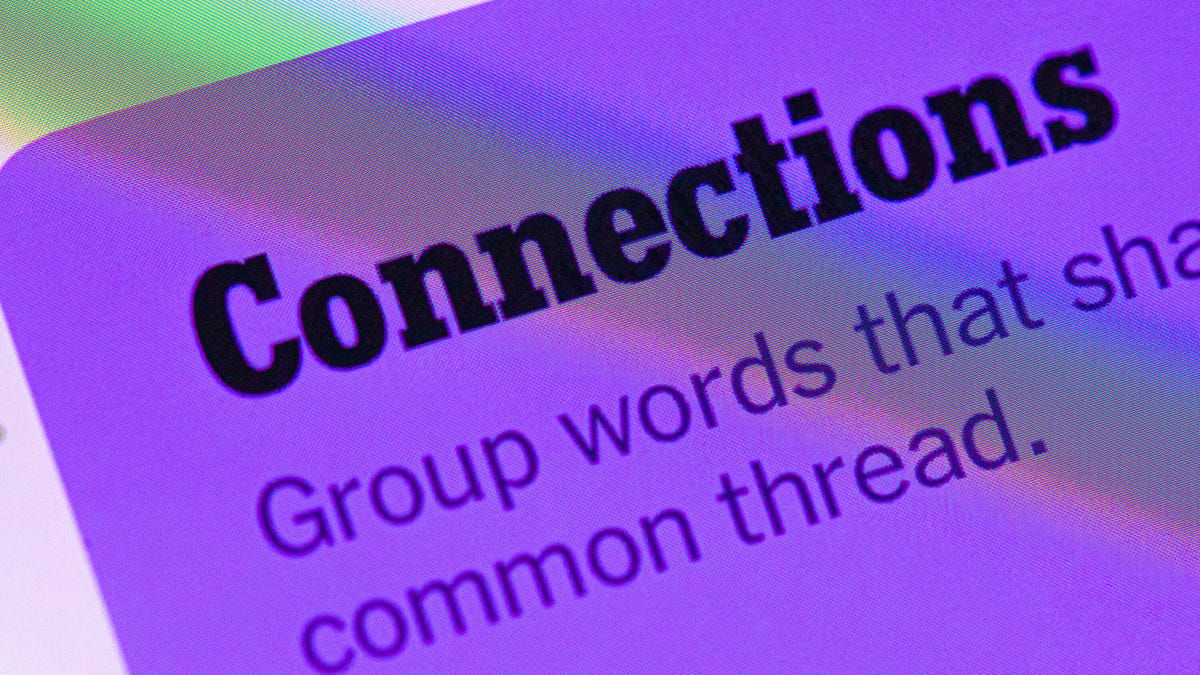
Looking for the most recent Connections answers? Click here for today’s Connections hints, as well as our daily answers and hints for The New York Times Mini Crossword, Wordle, Connections: Sports Edition and Strands puzzles.
Today’s NYT Connections puzzle is kind of tough. Ooh, that purple category! Once again, you’ll need to look inside words for hidden words. Read on for clues and today’s Connections answers.
The Times has a Connections Bot, like the one for Wordle. Go there after you play to receive a numeric score and to have the program analyze your answers. Players who are registered with the Times Games section can now nerd out by following their progress, including the number of puzzles completed, win rate, number of times they nabbed a perfect score and their win streak.
Read more: Hints, Tips and Strategies to Help You Win at NYT Connections Every Time
Hints for today’s Connections groups
Here are four hints for the groupings in today’s Connections puzzle, ranked from the easiest yellow group to the tough (and sometimes bizarre) purple group.
Yellow group hint: Cash out.
Green group hint: Chomp
Blue group hint: Walleye and salmon.
Purple group hint: Make a musical sound, with a twist.
Answers for today’s Connections groups
Yellow group: Slang for money.
Green group: Masticate.
Blue group: Fish.
Purple group: Ways to vocalize musically plus a letter.
Read more: Wordle Cheat Sheet: Here Are the Most Popular Letters Used in English Words
What are today’s Connections answers?
The yellow words in today’s Connections
The theme is slang for money. The four answers are bacon, bread, cheese and paper.
The green words in today’s Connections
The theme is masticate. The four answers are bite, champ, chew and munch.
The blue words in today’s Connections
The theme is fish. The four answers are char, pollock, sole and tang.
The purple words in today’s Connections
The theme is ways to vocalize musically plus a letter. The four answers are hump (hum), rapt (rap), singe (sing) and whistler (whistle).
Don’t miss any of our unbiased tech content and lab-based reviews. Add CNET as a preferred Google source.
Toughest Connections puzzles
We’ve made a note of some of the toughest Connections puzzles so far. Maybe they’ll help you see patterns in future puzzles.
#5: Included «things you can set,» such as mood, record, table and volleyball.
#4: Included «one in a dozen,» such as egg, juror, month and rose.
#3: Included «streets on screen,» such as Elm, Fear, Jump and Sesame.
#2: Included «power ___» such as nap, plant, Ranger and trip.
#1: Included «things that can run,» such as candidate, faucet, mascara and nose.
Technologies
Today’s NYT Mini Crossword Answers for Wednesday, Dec. 24
Here are the answers for The New York Times Mini Crossword for Dec. 24.

Looking for the most recent Mini Crossword answer? Click here for today’s Mini Crossword hints, as well as our daily answers and hints for The New York Times Wordle, Strands, Connections and Connections: Sports Edition puzzles.
Need some help with today’s Mini Crossword? I’m Irish-American, but yet 6-Down, which involves Ireland, stumped me at first. Read on for all the answers.. And if you could use some hints and guidance for daily solving, check out our Mini Crossword tips.
If you’re looking for today’s Wordle, Connections, Connections: Sports Edition and Strands answers, you can visit CNET’s NYT puzzle hints page.
Read more: Tips and Tricks for Solving The New York Times Mini Crossword
Let’s get to those Mini Crossword clues and answers.
Mini across clues and answers
1A clue: Wordle or Boggle
Answer: GAME
5A clue: Big Newton
Answer: ISAAC
7A clue: Specialized vocabulary
Answer: LINGO
8A clue: «See you in a bit!»
Answer: LATER
9A clue: Tone of many internet comments
Answer: SNARK
Mini down clues and answers
1D clue: Sharks use them to breathe
Answer: GILLS
2D clue: From Singapore or South Korea, say
Answer: ASIAN
3D clue: Large ocean ray
Answer: MANTA
4D clue: ___ beaver
Answer: EAGER
6D clue: Second-largest city in the Republic of Ireland, after Dublin
Answer: CORK
Don’t miss any of our unbiased tech content and lab-based reviews. Add CNET as a preferred Google source.
-

 Technologies3 года ago
Technologies3 года agoTech Companies Need to Be Held Accountable for Security, Experts Say
-

 Technologies3 года ago
Technologies3 года agoBest Handheld Game Console in 2023
-

 Technologies3 года ago
Technologies3 года agoTighten Up Your VR Game With the Best Head Straps for Quest 2
-

 Technologies4 года ago
Technologies4 года agoBlack Friday 2021: The best deals on TVs, headphones, kitchenware, and more
-

 Technologies4 года ago
Technologies4 года agoVerum, Wickr and Threema: next generation secured messengers
-

 Technologies4 года ago
Technologies4 года agoGoogle to require vaccinations as Silicon Valley rethinks return-to-office policies
-

 Technologies4 года ago
Technologies4 года agoOlivia Harlan Dekker for Verum Messenger
-

 Technologies4 года ago
Technologies4 года agoiPhone 13 event: How to watch Apple’s big announcement tomorrow
